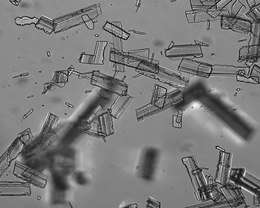Brushite
Brushite is a phosphate mineral with the chemical formula CaHPO4·2H2O. It forms colorless to pale yellow monoclinic prismatic crystals and as powdery or earthy masses.[2][4] It is the phosphate analogue of the arsenate pharmacolite and the sulfate gypsum.
| Brushite | |
|---|---|
 Possible Brushite crystals (not confirmed) found in bat guano in Jamaica | |
| General | |
| Category | Phosphate mineral |
| Formula (repeating unit) | CaHPO4·2H2O |
| Strunz classification | 8.CJ.50 |
| Crystal system | Monoclinic |
| Crystal class | Domatic (m) (same H-M symbol) |
| Space group | Aa |
| Unit cell | a = 6.265 Å, b = 15.19 Å, c = 5.814 Å; β = 116.47°; Z = 4 |
| Identification | |
| Color | Colorless to pale or ivory-yellow |
| Crystal habit | Prismatic to tabular acicular crystals; typically powdery or earthy |
| Cleavage | Perfect on {010} and {001} |
| Tenacity | Brittle |
| Mohs scale hardness | 2.5 |
| Luster | Vitreous, pearly on cleavages |
| Diaphaneity | Transparent to translucent |
| Specific gravity | 2.328 |
| Optical properties | Biaxial (+) |
| Refractive index | nα = 1.539 - 1.540 nβ = 1.544 - 1.546 nγ = 1.551 - 1.552 |
| Birefringence | δ = 0.012 |
| 2V angle | Measured: 59 to 87° |
| Solubility | Readily in HCl |
| Other characteristics | Piezoelectric |
| References | [1][2][3][4] |
Discovery and occurrence
Brushite was first described in 1865 for an occurrence on Aves Island, Nueva Esparta, Venezuela, and named for the American mineralogist George Jarvis Brush (1831–1912).[3] It is believed to be a precursor of apatite and is found in guano-rich caves, formed by the interaction of guano with calcite and clay at a low pH. It occurs in phosphorite deposits and forms encrustations on old bones. It may result from runoff of fields which have received heavy fertilizer applications.[3] Associated minerals include tanarakite, ardealite, hydroxylapatite, variscite and gypsum.[2]
Brushite is the original precipitating material in calcium phosphate kidney stones.[5] It is also one of the minerals present in dental calculi.
References
- Mineralienatlas
- Brushite in the Handbook of Mineralogy
- Brushite on Mindat.org
- Webmineral data
- "Brushite". Virtual Museum of Molecules and Minerals. Retrieved 22 December 2017.